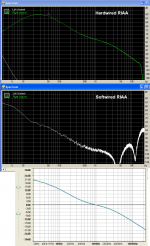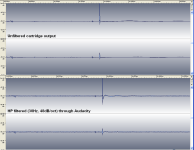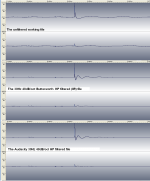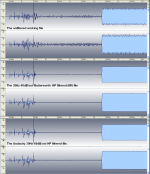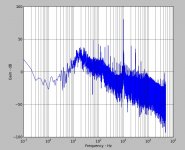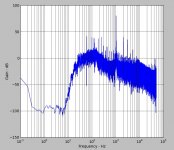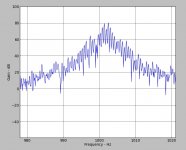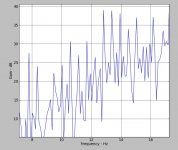Would like to think it can be made less nasty than shown.
I don’t consider it as nasty.
I found another KD-3100 to test. I put the same Stanton cartridge on it and recorded the same track.
https://www.dropbox.com/s/weqoob9uy17avwu/2nd%20KD-3100%20%26%20Stanton%20MK%20V%20cart.wav?dl=0
No difference in terms of FFT cogging indications btn the two KD-3100s.
George
Attachments
You must have an amazing collection of turntables!
No Bill. That was just a coincidence.
My bench has hosted many TTs which belong to friends or acquaintances but only for a few days, just for repair or adjustment (I only wish I had taken measurements on all these TTs)
Maybe 'nasty' was too strong a word, but I view it as something that could be reduced.
I would like to have a look inside this Kenwood but I don’t have the service manual for to do a detailed check on the motor drive (and I didn’t find it at vinylengine.com either)
George
Thanks for the measurements, George
You are welcome Pano. I hope they will be useful to some members.
I can't tell if the KD-3100 is phase locked (i.e. is there a motor drive issue or a fundamental motor issue).
Bill, you are right. I should have used the term ‘cogging’ only if I had confirmed that the rotational instability is an attribute of the motor and not of the driving circuit.
Now, Rega Planar 3 with Goldring Eroica H
It is the same 1kHz lateral 7cm/s track. The recording was made for another experiment (cartridge loading).
It is shorter than the rest I have posted (*), picks only one channel and it was flat. I added the RIAA playback curve and 30dB amplification using Audacity.
I post it for to show the very good damping especially at the horizontal plane and the large rotational velocity instability (two aspects that worry Bill
TT sample / Tone Frequency (HZ) / Tone frequency (musical note) / Tone instability (+/-Hz)
Rega Planar 3 / 997.87Hz / B4+18cents / 5.5
https://www.dropbox.com/s/xj0n214433f27cs/Rega%20Planar%203%20%26%20Goldring%20Eroica%20H%20cart.wav?dl=0
George
(*) making the maximum FFT resolution 0.042Hz
Attachments
Last edited:
Well to be honest, every time I think I have worked out what 'cogging' means in respect of DD turntables something comes up that makes me realise I need to do more research. Part of the reason I have collected a few DD turntables.Bill, you are right. I should have used the term ‘cogging’ only if I had confirmed that the rotational instability is an attribute of the motor and not of the driving circuit.
I post it for to show the very good damping especially at the horizontal plane and the large rotational velocity instability (two aspects that worry Bill)
Let's split the difference and call them 'areas for improvement'
It does interest me how much was 'forgotten' between 1975 and 1985 when I got my first turntable (youngster that I am
I added the RIAA playback curve and 30dB amplification using Audacity.
Don't forget if you're worried about phase Audacity is linear phase only on its equalizations.
Don't forget if you're worried about phase Audacity is linear phase only on its equalizations.
Thank you Scott, that’s a valuable information.
This is not mentioned in the manual of Audacity.
I may have to go back and recheck what I’ve done with the software equalization.
George
Thank you Scott, that’s a valuable information.
This is not mentioned in the manual of Audacity.
I may have to go back and recheck what I’ve done with the software equalization.
George
RIAA a single impulse and yee shall see.
RIAA a single impulse and yee shall see.
I did it and I don’t like what I see as the output of the Audacity (LF to 1kHz).
George
Attachments
I did it and I don’t like what I see as the output of the Audacity (LF to 1kHz).
George
If you look at the time domain you will see the non-causal nature of linear phase quite dramatically. At the Nyquist prompt you can run an IIR filter, it's in my LA article, and the results are fine down to DC.
Last edited:
I don’t consider it as nasty.
I found another KD-3100 to test. I put the same Stanton cartridge on it and recorded the same track.
https://www.dropbox.com/s/weqoob9uy17avwu/2nd%20KD-3100%20%26%20Stanton%20MK%20V%20cart.wav?dl=0
No difference in terms of FFT cogging indications btn the two KD-3100s.
George
Thanks for posting wave files. I've spent time listening to tracks, and applying various filters. Usining multiple notch filter to remove 1kHz signal and harmonics makes differences between setups very clear.
Link to filtered selections.
If you look at the time domain you will see the non-causal nature of linear phase quite dramatically. At the Nyquist prompt you can run an IIR filter, it's in my LA article, and the results are fine down to DC.
Thank you once again Scott for triggering my curiosity.
The capital controls measures that are imposed here became a bit relaxed and I was able to place an order for the #10 LA volume.
In about a week I will read your article.
Thanks for posting wave files. I've spent time listening to tracks, and applying various filters. Using multiple notch filter to remove 1kHz signal and harmonics makes differences between setups very clear.
Link to filtered selections.
Barleywater, thank you for the work you did on those files. Yes, notching the tone and it’s harmonics, leaves the subsonic signature of each set naked for comparison with other sets.
You give me the opportunity to emphasize the importance of reducing the subsonics of the mechanical parts by mechanical means.
No matter how much one reduces the subsonic content of the cartridge output by electrical or sw filtering, he can not undo the smearing of the signal caused by the subsonics (and he adds some more alterations to the signal).
I attach
a. FFTs from a cartridge direct out (before RIAA)
Technics SL-BD22D &P34 cart reading a 7cm/s lateral 1kHz track
b. FFTs from the cartridge direct out high pass filtered at 30Hz 48dB/oct through Audacity (FIR filter)
c. Screenshot (in the time domain) of the moment that the needle engages and falls in the lead-in spiral groove. Notice how the HP filter alters the shape of the impulse and slightly increases the surface noise.
https://www.dropbox.com/s/234b16q30rrkq2m/cartridge%20direct%20out.wav?dl=0
https://www.dropbox.com/s/tjq3bsx9e61qhwq/cartridge%20direct%20out%20through%20Audacity%2030Hz%2048dB%20HP%20filter.wav?dl=0
George
Attachments
I run some impulses through the Audacity LP and HP filters and they behave as IIP filters, not as FIR filters as I wrote above (*)
I had to do some more testing on this.
So I played the same vinyl track through the same TT/arm/cartridge as per previous post, then RIAA preamplified by Hagerman Bugle, and recorded. This is the master RIAA recording
https://www.dropbox.com/s/hvsfspmjyl4q0sy/The%20master%20RIAA%20recording.wav?dl=0
This master RIAA recording was played back and passed through the 2x4 MiniDSP in flat configuration and recorded at it’s output. This I call the unfiltered working file
https://www.dropbox.com/s/8ltj1qkqhixkvof/The%20unfiltered%20working%20file.wav?dl=0
The master RIAA recording was played back and passed through the 2x4 MiniDSP in 30Hz, 48dB/oct Butterworth HP filter configuration and recorded at it’s output. This is the 30Hz 48dB/oct Butterworth HP filtered (IIR) file. (**)
https://www.dropbox.com/s/6p08ycim099sjhx/The%2030Hz%2048dBoct%20Butterworth%20%20HP%20filtered%20%28IIR%29%20file.wav?dl=0
The master RIAA recording was imported in Audacity and processed through a 30Hz, 48dB/oct HP filter. The resulting file I call the Audacity 30Hz 48dB/oct HP filtered file.
https://www.dropbox.com/s/e5rk0g6x67a1bmf/The%20Audacity%2030Hz%2048dBoct%20HP%20filtered%20file.wav?dl=0
I find that the behaviour of Audacity HP filter apart from achieving better nulling at it’s stop band, is indistinguishable from the 2x4 MiniDSP HP filter.
More knowledgeable participants are welcome to comment.
George
(*) Same tests show the Audacity RIAA equalisation behaves as FIR filter
(**) 2x4 MiniDSP filters are IIR type filters
I had to do some more testing on this.
So I played the same vinyl track through the same TT/arm/cartridge as per previous post, then RIAA preamplified by Hagerman Bugle, and recorded. This is the master RIAA recording
https://www.dropbox.com/s/hvsfspmjyl4q0sy/The%20master%20RIAA%20recording.wav?dl=0
This master RIAA recording was played back and passed through the 2x4 MiniDSP in flat configuration and recorded at it’s output. This I call the unfiltered working file
https://www.dropbox.com/s/8ltj1qkqhixkvof/The%20unfiltered%20working%20file.wav?dl=0
The master RIAA recording was played back and passed through the 2x4 MiniDSP in 30Hz, 48dB/oct Butterworth HP filter configuration and recorded at it’s output. This is the 30Hz 48dB/oct Butterworth HP filtered (IIR) file. (**)
https://www.dropbox.com/s/6p08ycim099sjhx/The%2030Hz%2048dBoct%20Butterworth%20%20HP%20filtered%20%28IIR%29%20file.wav?dl=0
The master RIAA recording was imported in Audacity and processed through a 30Hz, 48dB/oct HP filter. The resulting file I call the Audacity 30Hz 48dB/oct HP filtered file.
https://www.dropbox.com/s/e5rk0g6x67a1bmf/The%20Audacity%2030Hz%2048dBoct%20HP%20filtered%20file.wav?dl=0
I find that the behaviour of Audacity HP filter apart from achieving better nulling at it’s stop band, is indistinguishable from the 2x4 MiniDSP HP filter.
More knowledgeable participants are welcome to comment.
George
(*) Same tests show the Audacity RIAA equalisation behaves as FIR filter
(**) 2x4 MiniDSP filters are IIR type filters
Attachments
Last edited:
I find that the behaviour of Audacity HP filter apart from achieving better nulling at it’s stop band, is indistinguishable from the 2x4 MiniDSP HP filter.
More knowledgeable participants are welcome to comment.
George
(*) Same tests show the Audacity RIAA equalisation behaves as FIR filter
(**) 2x4 MiniDSP filters are IIR type filters
You're probably running into some numerical noise issues with the miniDSP. Search for the Nyquist manual biquad filter and run the same biquads as you entered into the miniDSP in Audacity (I found you must use the LISP syntax). Now all computations are done floating point and you will get (~) no truncation noise. Careful to get the a's and b's in the right order. I never learned how to use Nyquist much so for 48dB slope you will have to repeat the Nyquist prompt 4 times. Maybe a guru out there knows how to do it all at once and assign it to a menu, I know it can be done.
Last edited:
George
The syntax is (biquad-m s b0 b1 b2 a0 a1 a2) where s is an Audacity specific Nyquist variable that automatically is the active waveform selection.
So it's just Audacity -> effect -> Nyquist Prompt and enter the above with the () necessary. IIRC the a's and b's are the same convention as miniDSP.
The syntax is (biquad-m s b0 b1 b2 a0 a1 a2) where s is an Audacity specific Nyquist variable that automatically is the active waveform selection.
So it's just Audacity -> effect -> Nyquist Prompt and enter the above with the () necessary. IIRC the a's and b's are the same convention as miniDSP.
I found an old file of the 1kHz tone from the Telarc Omnidisk. This is on the u-turn TT with the acrylic platter and Grado Black right out of the box. Left the raw file and right 4 biquad filters at 30Hz, Q = .5. Filters applied in Audacity with Nyquist plug-in.
(biquad-m s 0.99803939 -1.99607878 0.99803939 1.0 -1.996076859 0.9960807)
There appears to be a little DC offset in the file.
(biquad-m s 0.99803939 -1.99607878 0.99803939 1.0 -1.996076859 0.9960807)
There appears to be a little DC offset in the file.
Attachments
- Status
- This old topic is closed. If you want to reopen this topic, contact a moderator using the "Report Post" button.
- Home
- Source & Line
- Analogue Source
- Bad vibrations: Or taming your vinyl front end.


